
- 214 pages
- English
- ePUB (mobile friendly)
- Available on iOS & Android
eBook - ePub
About this book
The approach will be to give visual aid (illustrated) and written reference to young designers who are either launching their careers or taking their first stab at designing letterforms for a logo, lettermark, signage, advertising or an alphabet. The book will focus on the roots of each letterform and give the designers the knowledge of why weight variations (stress) exist and how to correctly apply them to their designs.
Key Features
Frequently asked questions
Yes, you can cancel anytime from the Subscription tab in your account settings on the Perlego website. Your subscription will stay active until the end of your current billing period. Learn how to cancel your subscription.
At the moment all of our mobile-responsive ePub books are available to download via the app. Most of our PDFs are also available to download and we're working on making the final remaining ones downloadable now. Learn more here.
Perlego offers two plans: Essential and Complete
- Essential is ideal for learners and professionals who enjoy exploring a wide range of subjects. Access the Essential Library with 800,000+ trusted titles and best-sellers across business, personal growth, and the humanities. Includes unlimited reading time and Standard Read Aloud voice.
- Complete: Perfect for advanced learners and researchers needing full, unrestricted access. Unlock 1.4M+ books across hundreds of subjects, including academic and specialized titles. The Complete Plan also includes advanced features like Premium Read Aloud and Research Assistant.
We are an online textbook subscription service, where you can get access to an entire online library for less than the price of a single book per month. With over 1 million books across 1000+ topics, we’ve got you covered! Learn more here.
Look out for the read-aloud symbol on your next book to see if you can listen to it. The read-aloud tool reads text aloud for you, highlighting the text as it is being read. You can pause it, speed it up and slow it down. Learn more here.
Yes! You can use the Perlego app on both iOS or Android devices to read anytime, anywhere — even offline. Perfect for commutes or when you’re on the go.
Please note we cannot support devices running on iOS 13 and Android 7 or earlier. Learn more about using the app.
Please note we cannot support devices running on iOS 13 and Android 7 or earlier. Learn more about using the app.
Yes, you can access Digital Type Design for Branding by Stephen Boss in PDF and/or ePUB format, as well as other popular books in Ciencia de la computación & Programación de juegos. We have over one million books available in our catalogue for you to explore.
Information
Subtopic
Programación de juegos
A
Oxen
The A is one of the earliest letters, and has held its spot in first place for several thousand years. The letter’s birthplace was Egypt, as a symbol for the ox, which was obviously held in high esteem by our ancient forebears. The Chinese had a special fondness for the ox evidenced by its inclusion in their Zodiac. The ox’s characteristics include steadiness countered with a bit of stubbornness.
The early semites drew this character to look like an 8 with the top cut off. The Phoenicians, which called their version the Aleph, drew it in a similar way to our modern K. Eventually they transformed it to look much like our present-day A, except upside down and tilted to the right. In the diagram you can see the reference to the horns, head and ears.
When the Greeks got their hands on it, they renamed it the Alpha, and rotated it 180 degrees. They eventually pointed it upright to create the modern Alpha.
The Etruscans appropriated the Greek Alpha and kept it in unchanged. The Romans perfected the design adding geometry and visual corrections to the design.
The A is the second most used letter in the English language, so its roots as a draft animal are understandable. Now that we know that the A is derived from the ox’s head, we can harness this energy. There are many options to work this energy into the letterform, ranging from weight, line quality, variation, slants and geometry. The A is one of the more common letters in the alphabet, and this workhorse of a letter’s history has earned its employment in our modern usage.
The ox at times needs to be yoked so that it gets its job done correctly, so when drawing an A for a complete typeface, it has to get along with the other characters in the family. This means the relationship of the horizontal and angled strokes have to be similar to the other characters to be visually appealing. This limits the creativity of the designer a bit, but it aids in readability. On the other hand, if you are drawing an A for a logo or custom lettering you can remove the yoke and let the ox be more expressive.
The visual energy from the A is derived from the angled strokes, so when drawing this letter, think of the energy an ox exerts while plowing a field or carting a load. Even though the reference to an ox’s head has been rotated 180 degrees, the energy still is completely directional. It moves your eye rapidly to the next letter form, so because of this, kerning becomes of utmost importance.
Drawing the A
The Greeks and Romans understood that the human eye had issues with lines, the lens tends to make columnar shapes pinch in their middle, flaring out at their tops and bottoms. To correct this they used Entasis to visually correct for this phenomena. Entasis adds a slight swelling to the column to visually correct for the issue. Type designers also use this approach to correct for the eye adding weight to stroke’s intersection, for example, some designers would taper the point where the A’s two angled strokes meet. Ink trapped typefaces show an extreme example of this.
It may be tough to make these tweaks if you are using a brush, nib, pastel or chalk, because the weight variations are achieved by pressure, the direction of the stroke and other variables. With most calligraphic letterforms, the weight variations are the most noticeable with rightward and leftward angles. Strokes leaning to the right tend to be heavier, and because of the downward motion and the angle of the pen’s nib. Because of this, many noncalligraphic typefaces have developed with a similar weight variation. Times New Roman is a great example of this. If you’re drawing vectors, these adjustments are made by the simple addition of Bezier points.
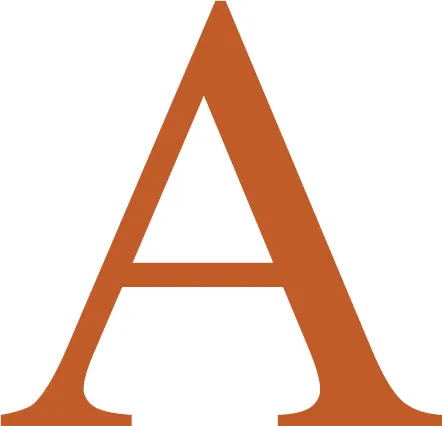
Times New Roman
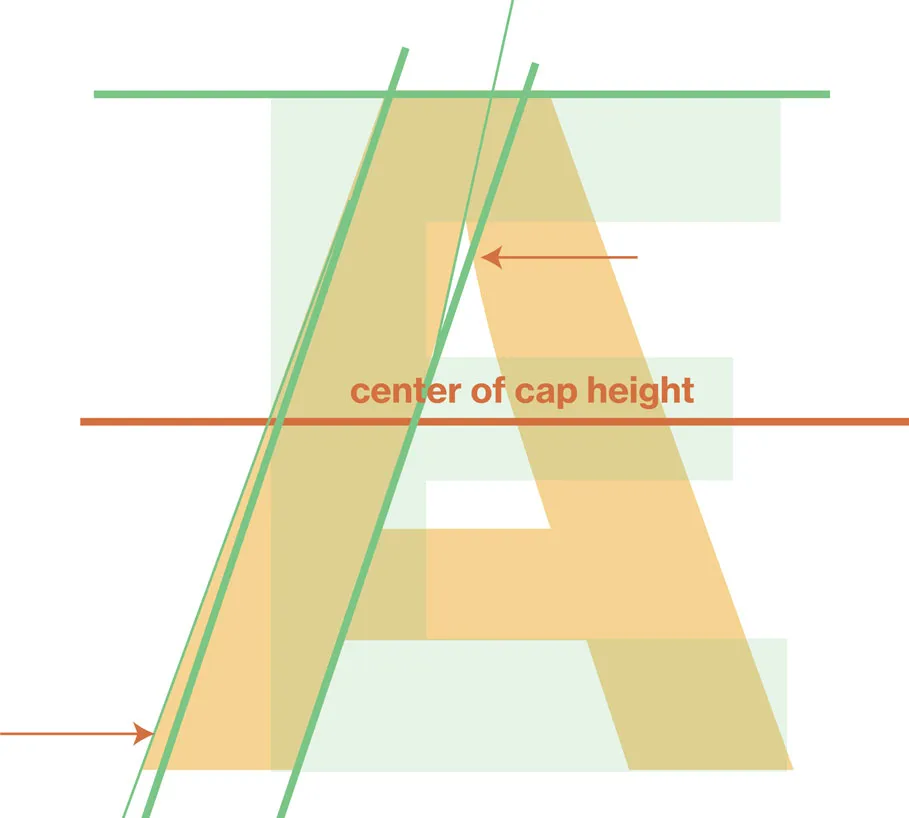
• Note the relationship of the A to the E, especially in the placement of the A’s hroizontal stroke or bar.
• In some designs, the diagonal strokes taper at the top or apex and flare at the bottom.
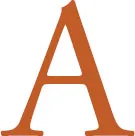
Humanist
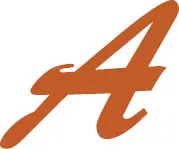
Brush

Geometric
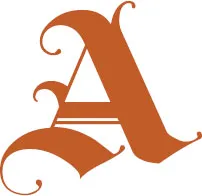
Blackletter

The lowercase a has an interesting background. The variation that has the curved shoulder on the top and the bowl on the lower half came into existence in the late Roman period. It was a way to simplify the writing process. The French later created a version that looked like a lowercase c closed by a vertical stroke on the right.
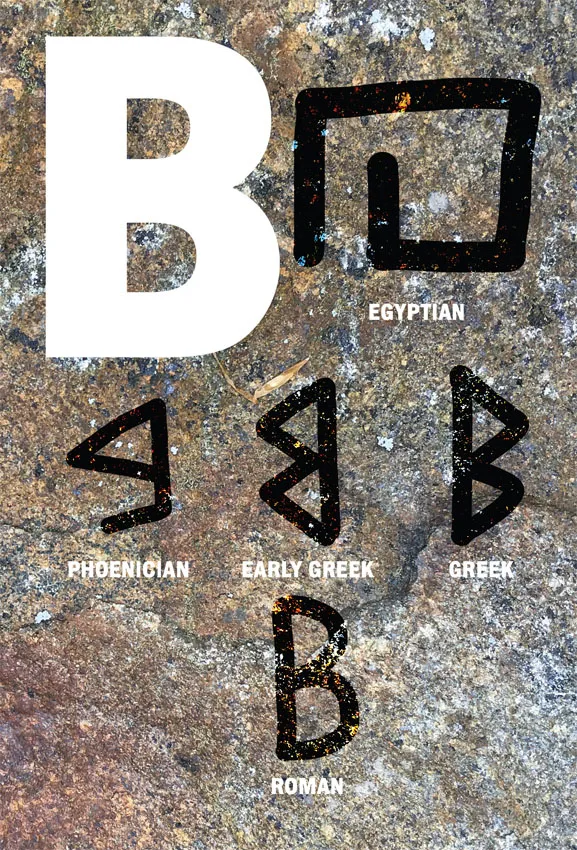
B
The letter B’s (formerly known as the Bayt) ancestors can also be traced back to Egypt. It was a glyph that represented shelter, as in housing. The idea of shelter was extremely important to the survival of our ancestors, it kept them out of the elements, and lent a degree of safety to their very existence. Many ancient cities that have the prefix “Beth” were named after housing, such as Bethel and Bethlehem.
The early Semites didn’t change the B much from the Egyptian design, but as the letter passed on to the Phoenicians, some changes occurred. They closed the shape up and angled the block shape, adding a left pointing angle to the design.
The early Greeks retooled the Bayt into their Beta by bending the slanted stroke to create the double arched side of the Beta. The Greeks eventually created a flipped version, for the purpose of writing from left to right.
The Etruscans used the right reading Beta, but once in the Roman’s hands, it had a facelift. The Romans visually corrected the B with minor tweaks, such as extending the bottom curve beyond the upper.
Drawing the B
It should comes as no surprise that the B’s foundation reflects our ancestor’s domiciles. The B has an almost structural feel to it, reminiscent of an architect’s floorplan. I visualize a two-story building with bay windows. In my opinion, the B is one of the more difficult letters to dra...
Table of contents
- Cover
- Half Title
- Title Page
- Copyright Page
- Table of Contents
- FM Introduction, map, cultures,
- Chapter 1 A
- Chapter 2 B
- Chapter 3 C
- Chapter 4 D
- Chapter 5 E
- Chapter 6 F
- Chapter 7 G
- Chapter 8 H
- Chapter 9 I
- Chapter 10 J
- Chapter 11 K
- Chapter 12 L
- Chapter 13 M
- Chapter 14 N
- Chapter 15 O
- Chapter 16 P
- Chapter 17 Q
- Chapter 18 R
- Chapter 19 S
- Chapter 20 T
- Chapter 21 U
- Chapter 22 V
- Chapter 23 W
- Chapter 24 X
- Chapter 25 Y
- Chapter 26 Z
- Chapter 27 Letter Frequency
- Chapter 28 Numerals
- Chapter 29 Designskolen Kolding
- Chapter 30 Interviews
- Chapter 31 Glossary and Resources
- Chapter 32 Bibliography